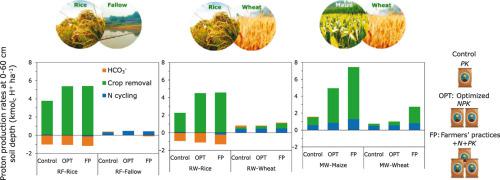Soil and Tillage Research ( IF 6.5 ) Pub Date : 2021-10-26 , DOI: 10.1016/j.still.2021.105230 Tianxiang Hao 1 , Xuejun Liu 1 , Qichao Zhu 1 , Mufan Zeng 1 , Xuanjing Chen 2, 3 , Linsheng Yang 2, 3 , Jianbo Shen 1 , Xiaojun Shi 2, 3 , Fusuo Zhang 1 , Wim de Vries 4, 5

|
Many Chinese croplands are suffering from soil acidification, defined as a decrease in soil acid neutralizing capacity (ANC), due to over-application of nitrogen (N) fertilizer and removal of base cations (BCs) in crop harvest. The contribution of fertilization and harvesting on soil acidification rates for different cropping systems is, however, seldom quantified under field conditions. Here, field experiments were conducted on a moderately acid silty clay soil in southwest China to quantify proton (H+) production rates under three fertilization management regimes, including control (non-N), optimized fertilization and farmers’ practices (i.e. over fertilization), by measuring the inputs and outputs of major element in three cropping systems, i.e. rice-fallow, rice-wheat and maize-wheat. The maize-wheat cropping system had the highest proton production rates (2.3–10.2 kmolc H+ ha−1 yr−1), followed by rice-fallow (3.2–4.6 kmolc H+ ha−1 yr−1) and rice-wheat (2.2–4.5 kmolc H+ ha−1 yr−1) systems. Crop removal, dominated by straw removal, was the main driver of proton production in all three cropping systems, contributing over 50% of the total H+ production. Compared to the control, N fertilizer application enhanced soil acidification rates among three cropping systems, but had no significant effects on H+ production per kg grain in the rice-fallow and rice-wheat systems. The same was true for the maize-wheat system in case of optimized fertilization, but over fertilization increased both soil acidification rate and H+ production per kg grain, while grain yield was comparable to that with optimized fertilization. The change in soil ANC was dominated by accumulation of SO42− (leading to potential soil acidification) that was mainly added to the soil with superphosphate containing high concentrations of both Ca2+ and SO42− sometimes even causing an increase in the base cation pool, despite BC crop removal. The low contribution of N transformation processes to the total H+ production (3–47%) was due to high denitrification in this specific soil. The soil pH and base saturation did not change significantly among the three fertilization management regimes, largely due to the large BCs pools in the soil. Although the common farmers’ practice does not strongly increase proton production in rice-fallow and rice-wheat systems, it still implies a waste of N fertilizer as the excess N input is either enhancing straw production or lost to air in this silty clay soil. Hence, optimized fertilization and localized BCs-rich straw return are suggested to reduce costs of N fertilizer without yield losses and mitigate soil acidification in those systems.


























 京公网安备 11010802027423号
京公网安备 11010802027423号